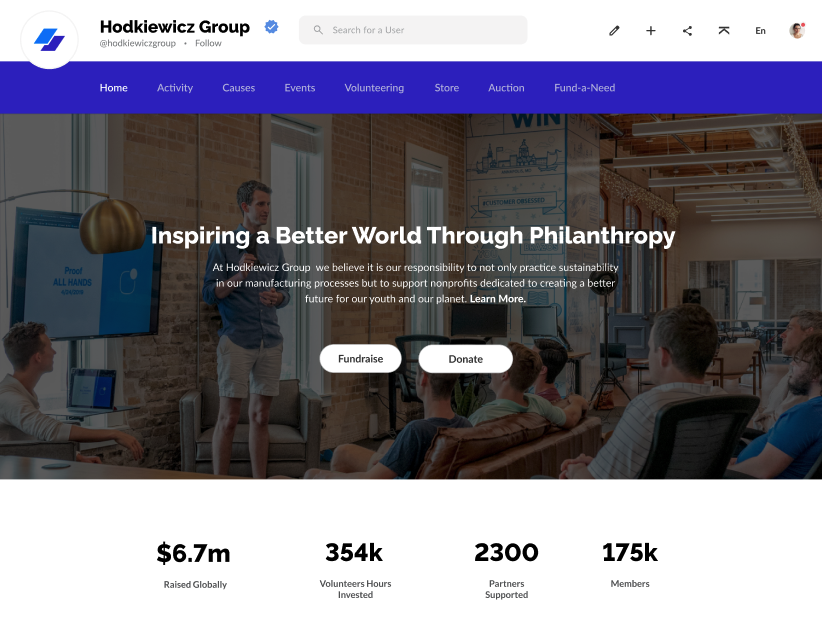Social good: A term your organization may be reading about through LinkedIn articles while discovering how other companies are taking action to make a positive difference in the world.
Whether your organization is undertaking various Corporate Social Responsibility (CSR) initiatives or is just beginning the first steps to starting a CSR program, these articles may spark a lingering question “What tool can help me achieve a greater level of social good?”
A social impact platform holds the golden key. A platform that lets your entire organization discover meaningful causes, search for corporate giving opportunities, and authentically track the results of your efforts.
You might have started doing some initial research on a few software companies; however, to effectively evaluate the right social impact platform for your organization, a website’s homepage with a list of features and benefits won’t suffice.
Below are 3 tips for evaluating a social impact platform to ensure it is the right fit for your organization:
Tip #1: Assess software against your challenges
Below is a list of common challenges organizations face when entering the world of corporate social responsibility—such as finding the right opportunities, monitoring their progress, and sharing their story.
You should evaluate each software company you are considering against each of these challenges; do they have the features and capabilities to resolve them?
a. Tracking volunteer hours
Your organization may already be implementing an employee volunteer program, where your employees are given a designated number of volunteer days per year to give back in ways that are meaningful to them.
Offering paid volunteer days is a start, but without proper tracking of volunteer hours, you won’t understand how much of an impact your employees are making.
When looking into social impact software, it should help your organization:
- Track all of your employees’ volunteer hours (after an employee completes and logs hours from a volunteer opportunity, this data should be captured on the backend and added to your organization’s total number of volunteer hours).
- Measure how many employees are volunteering.
- Track the number of causes your employees’ are supporting through volunteering.
b. Making & monitoring donations
Your organization may be donating to several causes, contributing to the $5 billion raised through workplace giving annually. However, you are unable to find a method to easily track which charities you are supporting and how much you are donating.
Additionally, you want to execute a workplace donation program that involves all of your employees, but the logistics of onboarding employees and tracking their contributions present itself as a barrier.
A platform should enable your organization to:
- Donate to the existing nonprofits & charities you support.
- Find new causes to donate to.
- Enable employees to select causes they believe in and donate.
- Monitor the total amount of donations at a company-wide level.
- Provide employees with the ability to monitor their individual donations.
c. Discovering and hosting fundraisers
From all of the walk-a-thons to golf tournaments to BBQs that local nonprofits and charities are hosting annually—there is a lot to keep up with. Which fundraisers will your employees attend? How can you employees organize a peer-to-peer fundraiser? How will your organization host a third-party fundraiser on behalf of a cause?
Although this may be a lot to digest when it comes to the world of event planning, find a platform that:
- Assists your organization in setting up a third-party fundraiser. Can you set up a customized event page within the platform that allows attendees (both employees and the general public) to register?
- Helps your employees discover upcoming fundraisers to attend in their local communities.
- Enables employees to execute a peer-to-peer fundraiser. Can your employees create personal fundraising pages to collect donations from their peers?
d. Communicating social impact
After all the effort you have made to encourage employee involvement and unite your staff around a shared purpose, communicating your social impact to stakeholders can be overlooked.
Social impact refers to the results of your social good initiatives. If you had 100 employees volunteer throughout the year, why not share how many volunteer hours they have accumulated to date? Your organization’s social impact is worth sharing to demonstrate your values, build brand equity, and inspire other changemakers.
When it comes to the communication aspect, find a platform where you can:
- Share your organization’s social impact through real-time, verified metrics. Is there a public dashboard where these results are made visible?
- Share photos and videos from company-wide efforts on an activity feed (i.e., media from your corporate volunteer days and fundraisers).
- Let employees share their social impact. Can each employee set up an individual profile within the platform to share their achievements?

Tip #2: Gauge Usability
Many software companies will offer live demonstrations to aid their customers in the decision-making process. This is your opportunity to see the inner workings of a social impact platform and gauge its usability.
When evaluating a social impact platform, consider the following questions to ask during the demo:
- How much time will it take to set up our company profile?
- What is the process for onboarding employees?
- Can we invite causes we are currently supporting to join the platform?
- How can our employees discover donation, volunteering, and fundraising opportunities?
- What metrics are tracked on a company-wide level and at an employee level? How are these metrics calculated?
Tip #3: Understand Return on Investment (ROI)
It may sound counterintuitive to discuss return on investment when discussing philanthropic work, but remember that your organization is adopting a social impact platform to benefit the wider community, create stronger brand awareness, and improve employee morale.
After your initial demo meeting, inquire about what your expected ROI would be after one year of using a social impact platform. As the platform will connect your employees with an ample amount of charitable giving opportunities, you’ll see a significant improvement in your organization’s social good productivity and employee morale.
Provide your organization size (as ROI will be dependent on this) and ask the software companies you are evaluating the following:
- Expected number of volunteer hours?
- Expected number of community donations?
- Expected number of retained employees?
- Employee retainment savings? (I.e., If we retain four employees in 1 year from using your software, how much will that save us)?

The goal of becoming more socially responsible is something that many organizations strive for, but without the right software in place, it may remain just a goal.
Evaluating a social impact platform that meets your organization’s size, needs, and preferences takes some time. However, when you don’t rush the process, you will find a robust tool to turn that ‘goal’ of corporate social responsibility into an ‘accomplishment.’




